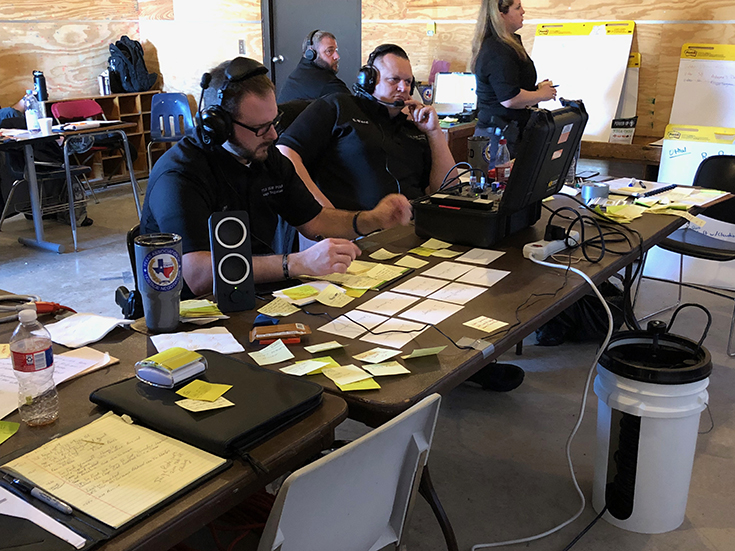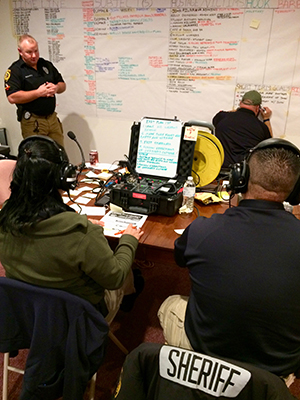Negotiator competition: Blessed are the peacemakers
In January 1990, Dr Wayman Mullins and Dr Michael McMains threw down the gauntlet to challenge their respective neighbouring hostage and crisis negotiation teams to a friendly competition. The aim was to see which one was the better at negotiating under pressure in a scenario-based exercise in San Marcos, Texas. Andrew B Brown and Wayman Mullins, take up the story.

Twenty-nine years later, the annual Texas State University the Annual Hostage Negotiation Training and Competition, has become essential active negotiation training for law enforcement and corrections teams from across the United States and the world.
Mullins is clear on the benefits of such immersive training: “Negotiators save lives. They come here for the training. The better trained they are, the better they do their jobs.”
A clear conclusion that can be derived from national data is that once negotiators respond to a critical incident, their success rate is about 97-98 per cent. Says Mullins: “Once negotiators begin a dialogue, innocent people don’t get hurt or killed; police officers don’t get hurt or killed and the bad guy doesn’t get hurt or killed. That’s all the justification you need for making these negotiators better at what they do.”
The conference and competition have been supported by seasoned negotiators who continue to practise the art of effective negotiations in a variety of environments and bringing their direct experience from both domestic and international hostage taking incidents. Some experience dates back to the initial days of hostage and crisis negotiation in the early 1970s when it was initially developed in the New York Police Department and then further developed by the Federal Bureau of Investigation (FBI). Why do they continue to do this? Law enforcement negotiators worldwide are part of a small community with a soul purpose of saving life through effective negotiation and they want to help prepare future generations of negotiators for what the world will throw at them.
The first day of the event is dedicated to classroom sessions and seminars that are designed to bring negotiators up-to-date with the latest research, skills building and case studies from across the world, all supported by recognised experts. Some of these trainers double as head judges to assess and critique the teams in the key skills of successful negotiations, assessing competency in the following critical areas:
Use of active listening skills – Minimal encouragers, open ended questions, reflect/mirror, emotional labelling, paraphrasing, iMessages, effective pauses and summary;
Pacing of communications – Can the negotiation progress the dialogue at a natural pace and develop rapport through both active listening and empathy?
Effectiveness of communication within the crisis response team – How does communication within the team and to command work in terms of decision-making and passing key information out and within the team?
Management and use of intelligence/information – This focuses on the ability to gather information, its analysis to make it useful and how it is then disseminated;
Use of intelligence board/display of intelligence and information – How the team develops and uses an intelligence board to help progress negotiations and support the primary negotiator. This takes cognisance of the fact that many teams effectively and efficiently share intelligence by digital means, but the physical use of boards is vital to the dynamic of effective negotiations;
Risk assessments – How does the team assess the risk in terms of the hostage taker, hostages and dynamic within the stronghold. Does this influence the dynamic and pace of negotiations?
Brainstorming issues – Does the team work together in discussing issues and how to overcome them? This activity is key in preventing the phenomenon of groupthink, which tends to rely on the opinion of one team member;
Handling of demands and time – Managing demands well leads to greater rapport and the development of trust between the negotiator and the hostage taker. It looks at how use various tactics to deal with demands, while not dismissing them;
Team functioning – Does the group function as a cohesive team rather than a collection of individuals? Judges analyse the four stages of team formation: Forming – members defining the task, discussions about what information needs to be gathered; Storming – members show their true styles, growing impatience over lack of progress, members will intrude on others areas causing irritation and general disagreement over progress, task and overall purpose of the team; Norming – ground rules, procedures taken seriously. Team discuss more with more time on decision-making, focus on specific topics, conflicts addressed and resolved; and Performing – productivity; tasks accomplished, proactive team, loyalty to the team with respect for each other even in disagreement.
Team Roles – Members know their roles and perform well in that role, including their contribution and interaction with others and do not perform the role of other team members; and
Use of Feedback – Following the morning session, teams are given feedback by the judges on a basis of three positives and three areas for development for each area of evaluation. This criterion looks at how the team implement this critical feedback in improving their performance.
The second and third day are dedicated to mock hostage negotiation exercises held at the Advanced Law Enforcement Rapid Response Training Range, San Marcos. Dr Mullins enlists students from the School of Criminal Justice, Texas State University. These students not only support the logistics of the conference and competition, but also play in ‘Bad Guy Central’, where they ably perform the roles of hostage taker and hostages and are coached by seasoned negotiators to ensure that teams are tested and challenged effectively. Prior to the competition, these students go through rigorous training sessions to learn their characters, proper emotions, making demands, etc. The exercises are scripted to a degree, so all student actors are doing the same things at the same time.
During the exercise teams are evaluated by judges, who are all experts, to help critique and guide the teams to better performance. Many of the participants, Mullins explains, find that this add more stress in the competition than they experience in a real-life situation, because their peers are watching them. The interaction allows teams to visit and observe other teams in action to pick up on techniques to improve and critically self-assess their own performance.
As you would expect in Texas, the competition finishes with a barbeque at the local community centre, where it is supported by the Dean of the School of Applied Arts, Texas State University, the San Marcos Police Chief, the Hays County Sheriff (the county where university and city are located) and their agencies. The participants, judges and students collectively pay respects to fallen colleagues and enjoy the networking as Dr Mullins announces the winners of the competition.
Coming to this competition in 2012 during my Fulbright Fellowship to investigate law enforcement negotiator training, I was impressed by the dedication of the teams to continually improving their technique and art of effective negotiations, so much so that I have been coming back each year to teach and judge.
There is no doubt that this competition, born out of a friendly wager, has contributed significantly to the professionalism of law enforcement negotiators, which is not only reflected in their performance but also their dedication to working with their local tactical teams regularly so they can be more effective in saving lives.

Crisis Response Journal, Volume 14:3, due to be published on June 20, features kidnap and ransom, hostage negotiation and responding to extortion. Andrew B Brown, one of the authors of this blog, writes about the Murky world of blackmail, extortion and witchcraft. Click here to subscribe.
Andrew B Brown and Wayman Mullins, 13/06/2019